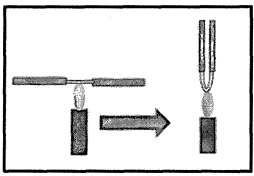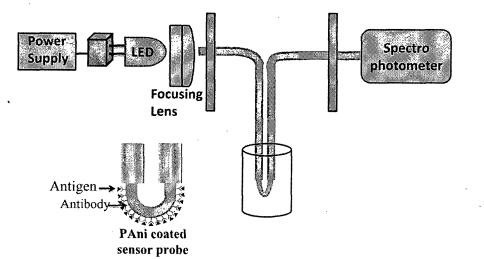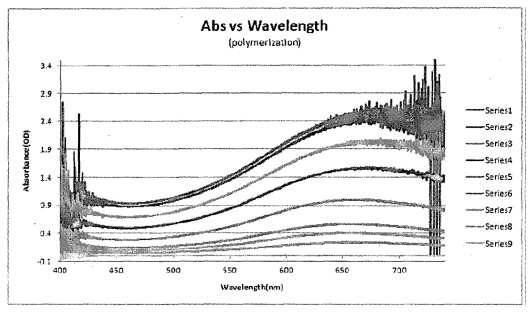The present invention relates to conducting polymer modified optical fiber particularly polyaniline modified optical fiber which results in spectral shifts on binding of different analytes to the receptor layers immobilized on the polyaniline layer, said analytes being heavy metal ions and protein molecules.
Figure (1) Procedure of preparing polyaniline coated U-bent optical fiber; (2) Procedure of preparing polyaniline coated U-bent optical fiber; (3) Depiction of real time polymerization optical absorbance of polyaniline synthesis on the surface of the fiber probe - different series (Series 9 to 1) indicate different point of time during polymerization
The development of highly sensitive, label-free biosensors for the detection of low concentrations of biomolecules and heavy metals (such as lead) in real-time remains a challenge. Existing biosensing techniques often face limitations in sensitivity, detection limits, and selectivity, making it difficult to detect low levels of analytes in environmental, medical, and industrial applications. There is a need for improved biosensors that can provide accurate and real-time detection of proteins and heavy metals with high sensitivity and low detection limits.
- Polyaniline-Coated Optical Fiber: The core of the innovation is the use of a conducting polymer (polyaniline) coated optical fiber that is highly sensitive to analytes.
- High Sensitivity and Selectivity: The optical fiber detects spectral shifts when analytes, such as protein molecules (e.g., human immunoglobulin G) and heavy metal ions (e.g., lead), bind to the polymer layer, enhancing detection sensitivity.
- U-Bent Fiber Design: The U-bent fiber configuration increases the interaction of evanescent waves with the surrounding environment, improving the sensor’s performance.
- Fast Response: Real-time monitoring allows for instantaneous detection of the analyte binding event, providing a quick response for both environmental and healthcare applications.
- Low Detection Limit: The sensor demonstrates a detection limit of 1 picomolar for lead ions, which is significantly better than traditional methods.
- Amorphous Polyaniline Structure: The amorphous nature of the polyaniline enhances the sensor's robustness and flexibility in different applications.
Analytes are substances or components that are being analyzed or measured in a sample during a scientific experiment or testing. In the context of biosensors, analytes could include various biomolecules, such as proteins, nucleic acids, or antibodies, or chemical substances, like heavy metals (e.g., lead), toxins, or pesticides, depending on the focus of the sensor or test. Essentially, an analyte is the target substance that the sensor or analytical method is designed to detect or quantify.
The technology is at hypothesis testing, demonstration in lab stage.
4
This technology significantly impacts various fields by providing a method for detecting toxic heavy metal contamination in water, air, and soil, helping to protect ecosystems. In health and diagnostics, it aids in detecting disease biomarkers like Human Immunoglobulin G, enabling early diagnosis and improving healthcare outcomes. It also ensures food safety by detecting heavy metals in food products. Additionally, due to the low cost of polyaniline, the sensor offers an affordable solution for environmental monitoring and diagnostic testing, making it widely accessible.
- Environmental Monitoring: Detecting toxic heavy metals (e.g., lead, arsenic) in water, soil, and air
- Healthcare: Diagnostic tools for detecting biomarkers like Human Immunoglobulin G (HIgG) and other disease-related proteins
- Food Safety: Detecting heavy metal contamination in food products, ensuring consumer safety
- Water Quality Testing: Rapid detection of heavy metals and pollutants in water sources
- Pharmaceuticals: Monitoring drug compounds and protein biomarkers during pharmaceutical development
Geography of IP
Type of IP
3890/MUM/2014
432936



